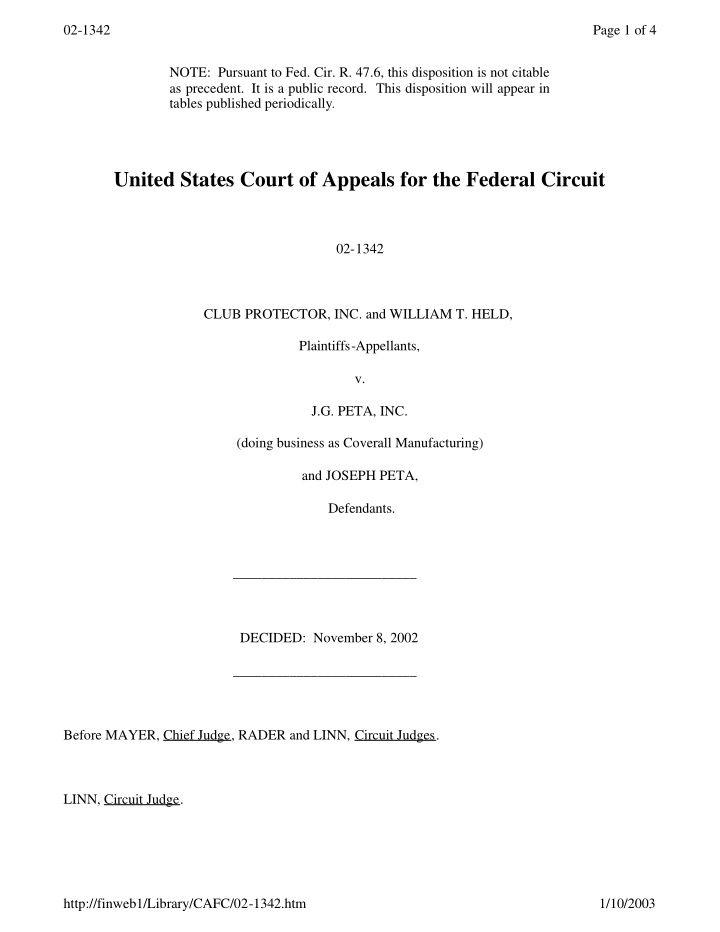



02-1342 Page 1 of 4 NOTE: Pursuant to Fed. Cir. R. 47.6, this disposition is not citable as precedent. It is a public record. This disposition will appear in tables published periodically . United States Court of Appeals for the Federal Circuit 02-1342 CLUB PROTECTOR, INC. and WILLIAM T. HELD, Plaintiffs-Appellants, v. J.G. PETA, INC. (doing business as Coverall Manufacturing) and JOSEPH PETA, Defendants. __________________________ DECIDED: November 8, 2002 __________________________ Before MAYER, Chief Judge, RADER and LINN, Circuit Judges. LINN, Circuit Judge. http://finweb1/Library/CAFC/02-1342.htm 1/10/2003
02-1342 Page 2 of 4 Club Protector, Inc. and William T. Held appeal from a decision of the United States District Court for the Western District of New York, which dismissed their complaint against J.G. Peta, Inc. and Joseph Peta. Club Protector, Inc. v. Peta, No 01-CV-0337E(Sr) (W.D.N.Y. Mar. 8, 2002). Plaintiffs’ complaint sought a declaratory judgment that Held was the rightful owner of the patent application that led to U.S. Patent No. 6,227,217 B1 (“the ’217 patent”), issued to Joseph G. Peta and assigned to J.G. Peta, Inc. The complaint also included causes of action for conversion and “intentional tort” under New York state law. The district court dismissed the complaint under Fed. R. Civ. P. 12(b)(6) for failure to state a claim. We affirm. Plaintiff Held is the owner of U.S. Patent No. 8,830,037 entitled “Canopy Attachment for a Golf Cart,” which issued on May 16, 1989 (“the Held patent”). Ten years after the issuance of the Held patent, defendant Joseph G. Peta filed a patent application that eventually issued as the ’217 patent. The ’217 patent is entitled “Roof Mounted Golf Bag Canopy.” The ’217 patent specification mentions the Held patent and describes the Held invention as lacking versatility and being difficult to install. See ’217 patent, col. 1, ll. 35-45. Plaintiffs claimed that Held was the inventor of the only “point of novelty” of the ’217 patent, and, therefore, was entitled to ownership of the patent. The district court correctly dismissed plaintiffs’ ownership claim, noting that the “invention” of one limitation in a combination claim does not make one the owner of the entire patent. Plaintiffs do not appeal the ownership cause of action. Instead, plaintiffs argue that the district court erred when it dismissed plaintiffs’ claim of “intentional tort” under state law. The question of whether a Rule 12(b)(6) motion to dismiss for failure to state a claim was properly granted is a purely procedural question not pertaining to patent law, to which this court applies the law of the regional circuit, in this case the Second Circuit. C & F Packing Co., Inc. v. IBP, Inc., 224 F.3d 1296, 1306, 55 USPQ2d 1865, 1872 (Fed. Cir. 2000) (citing Midwest Indus., Inc. v. Karavan Trailers, Inc., 175 F.3d 1356, 1359, 50 USPQ2d 1672, 1675 (Fed. Cir. 1999) (en banc in relevant part)). The Second Circuit reviews a dismissal for failure to state a claim upon which relief can be granted de http://finweb1/Library/CAFC/02-1342.htm 1/10/2003
02-1342 Page 3 of 4 novo. See, e.g., Conopco, Inc. v. Roll Int’l, 231 F.3d 82, 86 (2d Cir. 2000). We must accept as true all of the factual allegations in the complaint, make inferences from those allegations in the light most favorable to the plaintiffs, and liberally construe the complaint. See, e.g., Gregory v. Daly, 243 F.3d 687, 691 (2d Cir. 2001). We may affirm the district court’s dismissal “only if it is clear that no relief could be granted under any set of facts that could be proved consistent with the allegations.” Hishon v. King & Spalding, 467 U.S. 69, 73 (1984). New York courts recognize a cause of action for “prima facie tort.” See Curiano v. Suozzi, 63 N.Y.2d 113 (1984). The cause of action includes four elements: (1) intentional infliction of harm, (2) causing special damages, (3) without excuse or justification, (4) by an act or series of acts that would otherwise be lawful. Id. at 117. The district court dismissed plaintiffs’ cause of action noting that “while malice may have played a role in Joseph Peta’s seeking the ’217 patent, this Court is convinced that no amount of discovery could eliminate the possibility of a genuine business motive.” Club Protector, slip op. at 8. Plaintiffs argue that by dismissing the case for failing to show the third element of a prima facie tort, the district court made a factual determination beyond the scope of their complaint in violation of Rule 12(b)(6). We conclude, however, that even if the district court went beyond the scope of the complaint to find the third element missing, plaintiffs’ complaint does not allege the harm required to show the first element of a prima facie tort. Plaintiffs’ complaint only alleges that Held “invented” one limitation of a combination claim, not the patentable combination. By getting a patent on a unique combination of limitations, one does not deprive the “inventor” of a single limitation of any property right or otherwise harm that person. Plaintiffs’ complaint, thus, does not allege an “intentional infliction of harm,” and the complaint was properly dismissed. Finally, plaintiffs complain that when dismissing the complaint, the district court “did not expressly state whether it had construed the complaint as seeking the invalidity of the ’217 patent.” At the time plaintiffs filed their complaint, the ’217 patent had not issued. Thus, the complaint could not, as a matter of law, “seek to invalidate the patent.” The only issues before the district court were plaintiffs’ claims of ownership of the patent application and the tort claims. See Fed. R. Civ. P. 41(b); Kaster v. Modification Systems, Inc., 731 F.2d 1014, 1018 n.2. (2d Cir. 1984) (“The district court’s http://finweb1/Library/CAFC/02-1342.htm 1/10/2003
02-1342 Page 4 of 4 dismissal of appellants’ complaint, without leave to amend, would represent a bar to further action by appellants in both federal and state courts on the claims included in the dismissed complaint.”). The district court properly dismissed the case before it. http://finweb1/Library/CAFC/02-1342.htm 1/10/2003
Recommend
More recommend